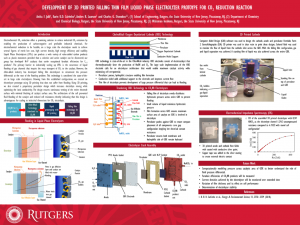Jalil, Anika: Development of Falling Thin Film Flow Cell for CO2 Reduction Reaction
Title: Development of Falling Thin Film Flow Cell for CO2 Reduction Reaction
Name: Anika Jalil
Major: Chemical Engineering
School affiliation: Douglass Residential College, Honors College, School of Engineering
Programs: Research for credit
Other contributors: Karin U.D. Calvinho, Anders B. Laursen, G. Charles Dismukes
Abstract: Anthropogenic CO 2 emissions are on the rise despite remarkable advancements in renewable energy. This discrepancy can be attributed to the difficulty of replacing established technology heavily reliant on fossil fuels.
Electrochemical CO 2 reduction offers a promising solution to reduce industrial CO 2 emissions by enabling the
profitable production of industrial chemicals from waste CO 2 .
For electrochemical reduction to be feasible, an electrolyzer needs to achieve several figures of merit: high
current density into desired products, energy efficiency to reduce heat loss, and stable operation. Liquid phase
electrolyzers (LPEs) confer an advantage over gas phase electrolyzers (GPEs) by operating at higher current
densities that imply lower capital costs. Additionally, LPEs can produce a wide variety of liquid C n carbon products such as plastic monomers; GPE products are restricted to gaseous C 1 products of low value.
The primary barrier to industrially scaling up LPEs is the occurrence of liquid flooding of gas channels that
impair the mass transport of gaseous CO 2 to the catalyst. However, the chlor-alkali industry has produced falling
film electrolyzers to circumvent the pressure differential, the root cause of flooding. This technology is the current state-of-the-art in large scale electrolyzers. In a falling film configuration, the electrolyte runs from the top of the cell down by gravity, counteracting the hydrostatic pressure with the hydrodynamic pressure drop, eliminating differences in pressure over the height of the electrode. Drawing from this established configuration, we created an advanced flow-field prototype that eliminates flooding in traditional CO 2 electrolyzers.
Using 3D printing, we created a percolator that provided a hydrophilic interface for liquid film formation,
ensuring wetting of the entire electrode surface that enables short distance transport of CO 2 to the catalyst surface with minimal transport lag. The architecture of the cell prevented fluid flooding of the catalyst and conferred significantly lower uncompensated resistance compared to existing lab-scale CO 2 RR electrolyzers. The cell was further tested using Ni-P catalysts to quantify current densities and faradaic efficiencies for monoethylene glycol (MEG) production. These metrics are compared to the performance of the standard sandwich electrolyzer configuration. The high current densities and faradaic efficiencies of the flow cell indicate its eligibility for industrial scale CO 2 electrolysis.
